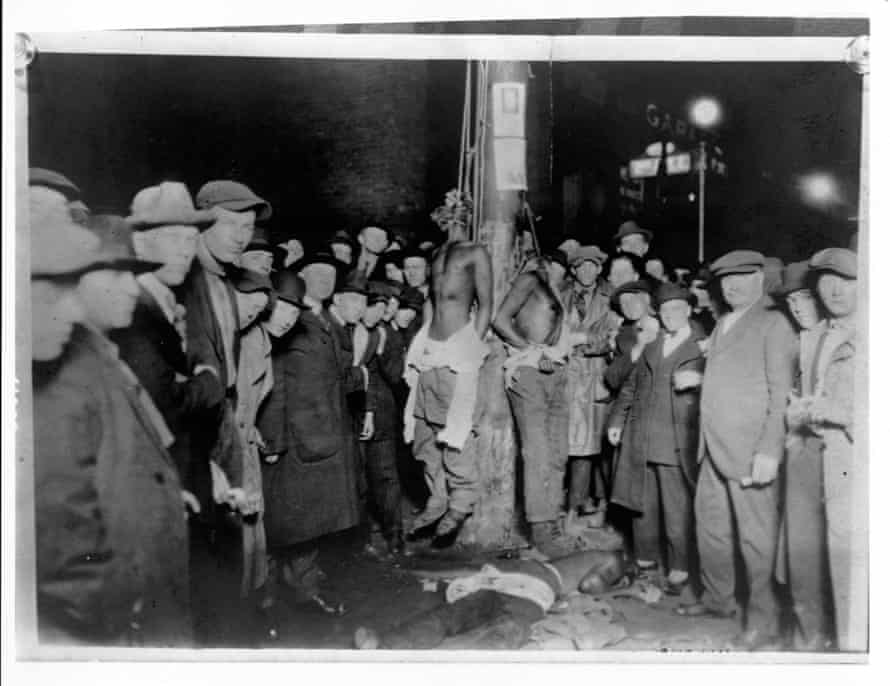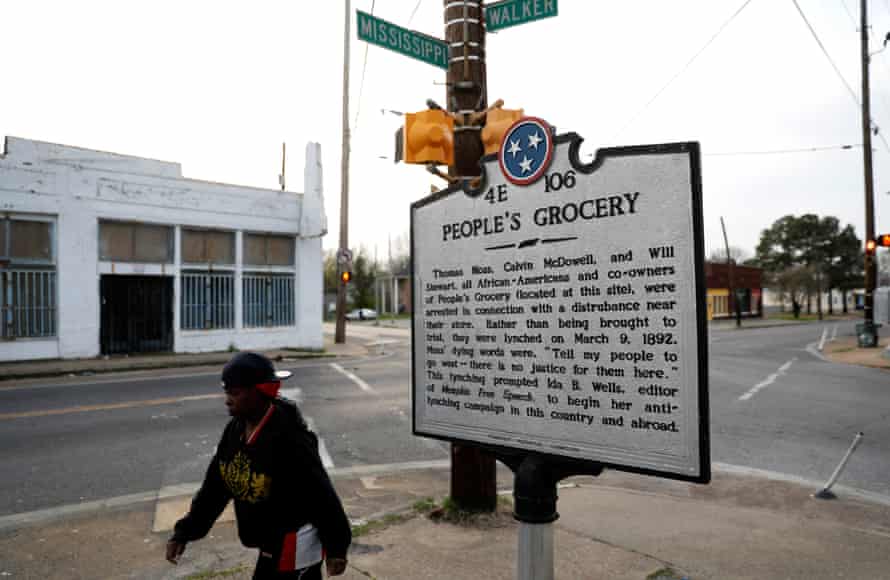What Did Ida B. Wells Do to Improve Family Life?
T oday, a simple marker on a street corner in Memphis, Tennessee commemorates the People's Grocery lynching. In 1892 three black men, co-owners of a shop giving white businesses a run for their money, were attacked, fought dorsum and were arrested. They never stood trial. A white mob bankrupt into the jail, dragged them away and lynched them.
The murders were grieved by their friend Ida B Wells, an African American teacher, announcer, civil rights pioneer and suffragist nearly whom information technology was once said: "She has plenty of nerve; she is as smart as a steel trap, and she has no sympathy with humbug."
Wells was galvanised to count, investigate and report lynchings in America as no i had washed before, hurling her 5ft frame into hostile territory with all the fearlessness of a state of war reporter.
For a century she has languished equally an unsung heroine, overshadowed by more familiar giants of the ceremonious rights movement. In recent years, notwithstanding, her crusading activism and muckraking techniques are being rediscovered. A social club for investigative reporting bears her name; the New York Times – which once branded her "a slanderous and nasty-minded mulattress" – just published a belated obituary, and there are moves to name a street after her in New York and build a monument in Chicago.
"I consider her my spiritual grandmother," says Nikole Hannah-Jones, an investigative journalist covering ceremonious rights. "She was was a trailblazer in every mode ... as a feminist, as a suffragist, as an investigative reporter, as a civil rights leader. She was merely an all-around badass."
Wells was born into slavery in Holly Springs, Mississippi, during the civil state of war. She was orphaned at 16 after her parents – likewise equally a younger blood brother – died from a xanthous fever epidemic. She plant work as a teacher to support her five remaining siblings, and then moved to Memphis, where she became a leading journalist and civil rights activist.
At 21, Wells clashed with a white train conductor who ordered her to motility from the ladies' car to the a section designated for black passengers, despite her having bought a first class ticket. When she refused and the conductor tried to forcibly move her, Wells "attached her teeth on the dorsum of his hand", as she wrote later.
Wells sued after existence ejected from the train and won the case (a newspaper headline alleged "Darky damsel gets amercement"), though the decision was later reversed in court.
By the time Wells turned 25, she was the co-owner and editor of the Free Spoken language and Headlight, a local black newspaper, a platform she used to skewer racial inequality. Then came the People's Grocery Lynching. She denounced it in impress, armed herself with a pistol and spent months traveling lone in the southward, researching more than 700 lynchings from the previous decade.
Some four,075 African Americans were lynched in 12 southern states between 1877 and 1950, according to the Equal Justice Initiative'southward 2015 report, Lynching in America. Some were witnessed by big crowds who brought children and picnic baskets, every bit if at a public amusement.

Wells'southward great-granddaughter, Michelle Duster, an author and public speaker, says: "They would torture people earlier they were killed and dismember them later and pass around the body parts. Information technology was shocking to me that people would accept basic as souvenirs. The more I learned about the level of violence, the more I appreciated what information technology took for her to practise what she did. I am just amazed."
Wells visited places where people had been hanged, shot, beaten, burned alive, drowned or mutilated. She examined photos of victims hanging from trees as mobs looked on, pored over local newspaper accounts, took sworn statements from eyewitnesses and, on occasion, even hired individual investigators.
It was astoundingly courageous work in an era of Jim Crow segregation and in which women did not have the vote. Hannah-Jones, who writes for the New York Times Magazine, says: "At that place was no protection from the law for a black adult female who was going into territories where black people had been stolen from the jail and lynched with the help of constabulary enforcement.
"These places would take been hostile to a black person questioning these communities at all, but remember near the types of emotion in a community that has only lynched someone and strung their torso upwards for public display and then to take a black woman come in at that place request questions. One has to ask: 'Would I take the courage to do that?' There was no aid that was going to come for yous. There was no protection from the law. Black folks didn't even have a lot of legal rights and they certainly didn't accept much protection from police force enforcement."

Wells, however, was a strength of nature who once said, "One had better die fighting injustice than die similar a dog or a rat in a trap." On another occasion, she wrote: "I had already adamant to sell my life as dearly every bit possible if attacked. If I could take one lyncher with me, this would even up the score a little bit."
She destroyed the mainstream media'due south narratives that suggested lynching victims were criminals – often rapists of white women – who got their just desserts. Her reporting showed that rape had not been declared in two thirds of the lynchings or was but alleged later on a covert, consensual, interracial relationship had been exposed.
Duster says: "She was putting names to stories and names to statistics. She was putting context into what was happening. Without what she did, information technology was pretty much 'OK, this person committed a crime, they got what they deserved.' She said, 'No, they did not commit a crime.' The narrative of the mainstream media at this time was very dissimilar from the reality she establish on the ground."
Hannah-Jones adds: "Much like the killing of black people by police today, the 'official' story of lynchings was just largely accepted, which was that black men were rapists and that unknown vigilantes were only meting out justice to black brutes. You can look at the fashion that newspapers covered these things and that was but accepted and Ida B Wells exposed the reality behind lynchings, which is that they were often used as economical retaliation.
"They were used to sow fear in black communities so that blackness people would stay in their identify and she exposed the truth about that. She also exposed that while law enforcement would oft say they these lynchings occur 'at the hands of parties unknown', everyone in town knew who committed them and ofttimes police enforcement took part."
While Wells was out of town, a mob destroyed her press press in Memphis and threatened to kill her if she returned. She stayed away from the s for more than than three decades but toured the US and United kingdom of great britain and northern ireland, raising awareness through public speaking. In 1895 she published a pamphlet, the Red Record, the first statistical record of the history of American lynchings, a precursor of data journalism projects such every bit The Counted, the Guardian's project to certificate people killed by police.
Hannah-Jones says: "She was one of the commencement people to really tally the number of lynchings that were happening. Nosotros like to say she was 1 of our early data reporters. She began to collect data on this to show how actually vast the scope of the trouble was."
Wells married Chicago lawyer and newspaper editor Ferdinand Barnett and, uncommonly for the time, hyphenated her proper name rather than take his. The couple had four children. Wells jugged motherhood, journalism and civil rights. In 1909, she was one of the founders of the National Association for the Advancement of Colored People (NAACP), although was later ousted considering she was perceived as also "radical". She also worked with Susan B Anthony as a leader in the movement for women'due south suffrage.
When Wells died in 1931 at the age of 68 from a brief illness due to kidney failure, her influence was waning, her autobiography was unfinished and her appetite of a federal anti-lynching law was unrealised. Squeegee muses: "She went out with a whimper. She was almost obsolete. She writes in her autobiography that there was a generation who didn't know who she was and didn't know well-nigh lynching. She wrote the volume to stop information technology being forgotten."
Wells and Barnett are interred together in the Oak Forest cemetery in Chicago. She remains a little known figure in America and away. Hannah-Jones, who adopted the Twitter handle Ida Bae Wells, reflects: "A lot of people have no thought who Ida B Wells is. To this mean solar day people think my name is Ida; they don't even get the reference of my Twitter handle.
"I think her existence a woman, and a black adult female, were things that pretty much guaranteed her obscurity. She was also written out of the suffrage movement even though she played a huge office in information technology and was trying to push the white suffragists on racial equality. Both her gender and her race are the reasons why she was largely written out of history."
But now she is inspiring a new generation of women in journalism. Hannah-Jones is co-founder of the Ida B Wells Guild for Investigative Reporting, which aims to increase the ranks, retentivity and profile of reporters and editors of colour in the field.
What if Wells herself were alive today? "I think she would be very unsurprised past the America of 2018," she says. "In many ways it would look very familiar to her. As long every bit she was able, she would be one of the sharpest critics of this state right at present."
Source: https://www.theguardian.com/world/2018/apr/27/ida-b-wells-civil-rights-movement-reporter
0 Response to "What Did Ida B. Wells Do to Improve Family Life?"
Post a Comment